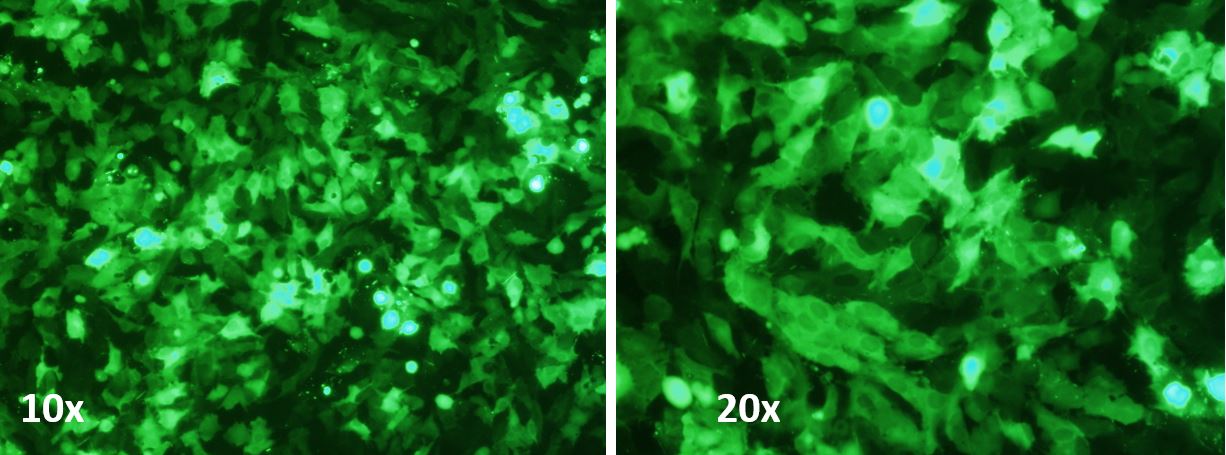Description
Cell to transfect:
Designations: BT-20
Cell Synonyms: : HTB-19, human breast carcinoma cell
Depositors: EY Lasfargues
Growth Properties: adherent
Organism: Homo sapiens
Morphology: epithelial
Source: Organ: mammary gland; breast
Disease: carcinoma
Isolation date: 1958
Tumorigenic: Yes
Antigen Expression: HLA A1, Bw16 (+/-)
Age: 74 years
Gender: female
Ethnicity: Caucasian
Comments: The cells express the WNT3 and the WNT7B oncogenes. This breast tumor line was established by E.Y. Lasfargues and L. Ozzello in 1958 by isolation and cultivation of cells spilling out of the tumor when it was cut in thin slices. Growth of BT-20 cells is inhibited by tumor necrosis factor alpha (TNF alpha). BT-20 cells are negative for estrogen receptor, but do express an estrogen receptor mRNA that has deletion of exon 5.
Features of The Transfection Reagent:
- Broad spectrum for the transfection of large plasmid, mRNA, siRNA, and/or other type of nucleic acids, which is best for co-transfection of different type and/or size of nucleic acids.
- Specifically optimized to deliver nucleic acids into BT-20 cells
- Highest efficiency to ensure experimental success
- Extremely gentle to cells
- 0.5 ml is able to transfect about 1000 wells of 24-well plate
- Efficient for plasmid DNA/siRNA co-transfection
- Compatible with serum
- Suitable for Reverse Transfection
- Compatible with transfection in any plate formats
- Economical: High efficiency means less amount of nucleic acid & reagent is needed
Data
 FIG. 1. High throughput test of transfection efficiency (determined as RLU/mg) on MDA-MB-453 cells after transfection of luciferase reporter gene by using our 172 proprietary transfection formulas and several most popular commercial transfection reagents. The yellow box showed the results of 4 commercial transfection reagents. The red lines marked our candidate formulas with the highest transfection efficiency for MDA-MB-453 cells. This test result was confirmed with repeat experiments. The candidate formulas were also tested on BT-20 cells by transfecting GFP expression plasmid, and got the same high transfection efficiency after flow cytometry analysis. The one that showed the optimal balance of potent & low cytotoxicity (percentage of 7AAD positive cells) among those candidate formulas was later named as BT-20 Cell Avalanche® Transfection Reagent.
FIG. 1. High throughput test of transfection efficiency (determined as RLU/mg) on MDA-MB-453 cells after transfection of luciferase reporter gene by using our 172 proprietary transfection formulas and several most popular commercial transfection reagents. The yellow box showed the results of 4 commercial transfection reagents. The red lines marked our candidate formulas with the highest transfection efficiency for MDA-MB-453 cells. This test result was confirmed with repeat experiments. The candidate formulas were also tested on BT-20 cells by transfecting GFP expression plasmid, and got the same high transfection efficiency after flow cytometry analysis. The one that showed the optimal balance of potent & low cytotoxicity (percentage of 7AAD positive cells) among those candidate formulas was later named as BT-20 Cell Avalanche® Transfection Reagent.
 FIG. 2. BT-20 cells were transfected with GFP vector (pEGFP-N3) by using BT-20 Cell Avalanche® Transfection Reagent. The cells were visualized by Nikon Eclipse Fluorescence microscope 48 hours post transfection.
FIG. 2. BT-20 cells were transfected with GFP vector (pEGFP-N3) by using BT-20 Cell Avalanche® Transfection Reagent. The cells were visualized by Nikon Eclipse Fluorescence microscope 48 hours post transfection.
For Other Cells
BT-20 Cell Avalanche® Transfection Reagent (human breast carcinoma cell) can also be used on the following cells with high transfection efficiencies.
4T1 Cell
ZR-75-1 Cell
MDA-MB-453 Cell
HCC1937 Cell
MDA-MB-468 Cell
SK-BR-3 Cell
MDA-MB-231 Cell
293 Cell
293T/17 Cell
Recommended protocols for these cells will be provided with the reagent. The protocols usually provide satisfactory transfection efficiency with invisible cytotoxicity. However, optimization may be needed for certain type of cells. Optimizations may include: the amount of DNA and this transfection reagent; cell density; transfection reagent/DNA ratio, or incubation time for the mixture of transfection reagent/DNA etc. For best transfection result, we recommend using the respective cell type/cell line specific Avalanche transfection reagents. Those reagents have been optimized on both recipes and protocols, and have been proved to have the best transfection results for the respective cell lines or primary cells. You can easily find the respective Avalanche transfection reagents specific for your cells by using the filters of our product list.
Additional Information
| Weight | 0.5 lbs |
|---|---|
| Adherence Phenotype |
Adherent |
| Cell Type |
Epithelial Cell |
| Disease |
Cancer |
| Names starting from |
B |
| Primary/Cell Line |
Cell Line |
| Product Sizes |
0.5 ml, 1.5 ml |
| Species |
Human |
| Tissue Sources |
Breast/Mammary |
| Subcategories |
Cell Type/Cell Line Specific |
Documents
Citations or Feedback


